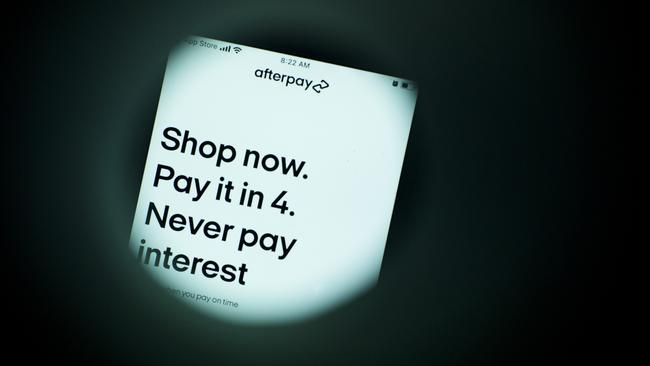The buy now, pay later reckoning is long overdue

Treasury officials, as outlined in a discussion paper the department released on Monday, worry that slack regulation and the high growth of BNPL could hurt vulnerable Australians.
The release of the discussion paper was met with a clarion call from the Financial Counselling Australia. They say BNPL must be part of the Credit Act like credit cards and other credit products.
Afterpay’s co-founders Anthony Eisen and Nick Molnar’s genius was less in their much touted innovation around the product, which has quacked like a credit duck from the moment it broke out of the egg, than their Oscar winning lobbying.
The BNPL sector lobbied the former Morrison government, the Treasury, the Australian Securities and Investments Commission and the Reserve Bank. Each of these had power to do something about BNPL regulation.
In November 2020, an ASIC report found that while most BNPL was marketed as a budgeting tool or a way to make purchases more affordable, one in five users had missed a payment in the previous 12 months.
Just one year earlier both Afterpay and Zip Co had poached senior executives from ASIC.
Until now, BNPL has been allowed to rise outside of the Credit Act, unlike banks which must do credit checks on customers – “quite a feat” as Commonwealth Bank chief Matt Comyn told a parliamentary economics committee back in April last year.
Eisen and Molnar sold out to Square ahead of the tech meltdown in August last year and laughed all the way to the bank.
Labor should be congratulated for moving on BNPL but even if the government does decide to put it under the Credit Act – and there is no certainty – it will be months before a decision is implemented.
Ahead of that, expect a rush for business from BNPL. And that is unfortunate because we have a growing cost of living problem.
Consumers are free to take out any number of BNPL accounts from different providers. The FCA’s Fiona Gurthrie says proof that self-regulation is not working is that financial counsellors have been seeing “soaring numbers of people harmed by BNPL”, many of whom are on low incomes.
She argues nothing short of fully regulating BNPL as credit will work. Two other options explored by the Treasury paper – an affordability test in BNPL’s voluntary code or partly bringing BNPL into the credit code by introducing a sliding affordability test – would only see the problems continue.
In the week running up to the Black Friday and Cyber Monday spendathons, there are clear signs the big banks have concerns about consumer credit.
Banks have a unique window on the financial condition of their customers (except of course that they have no sight on BNPL debt).
On Monday, CBA announced a new flight to quality strategy for its home loans and National Australia Bank warned against payday lending ahead of Christmas.
CBA is offering rates as low as 4.57 per cent for new customers who already own at least 40 per cent of their home.
Rate City points out that CBA is now posting publicly advertised rates, not the deal that a customer might be offered behind closed doors which is common in mortgage lending. Owner occupiers with good equity are a hot commodity as rates continue to rise and property values fall. But these are the financially sound Australians and NAB’s warning on Payday lending with its hidden costs and high interest rates is equally poignant. NAB research also released on Monday reveals one in 10 Australians facing financial hardship have accessed a payday loan in the past three months.
Last month, the government announced a crackdown on payday lending with legislation to be considered including a 10 per cent cap on the amount of income that lenders could access.
BNPL got its momentum with the huge stimulus unleashed during the Covid-19 pandemic and in the 12 months to June some 7 million active accounts recorded $16bn in transactions, up 37 per cent in that time alone. But stimulus is draining away and there is no transparency on the credit position of vulnerable Australians because the BNPL piece is missing, a point made by Treasury.
Roll on the weekend. The latest survey for CBA by House of Brand Group of over a thousand people between November 3 and November 8 found that almost 4 in 10 would take part in Black Friday and Cyber Monday sales to get ahead on Christmas shopping.
BNPL’s other big claim is that it brings new sales for retailers. This remains a moot point. Most retailers I speak with are as much driven by a fear of missing out on existing sales because the market now demands BNPL for shoppers.
In April last year, when Afterpay was one of the ASX’s 20 largest companies and its smaller rival Zip was still bigger than Ansell, I predicted a reckoning for BNPL. A Macquarie research note warned of increasing regulatory pressure. That proved premature.
In response to the Treasury paper, BNPL’s peak body – the Australian Finance Industry Association – has to speak for an Afterpay that wants to work with the voluntary code and a Zip which is already a regulated credit provider in parts of its business.
AFIA’s response to Treasury’s paper is that it does not oppose regulation but that it needs to be “right-sized” and “fit for the future” – whatever that means.
Either way, expect the industry’s lobbying to continue.







A regulatory reckoning for buy now, pay later is long overdue.